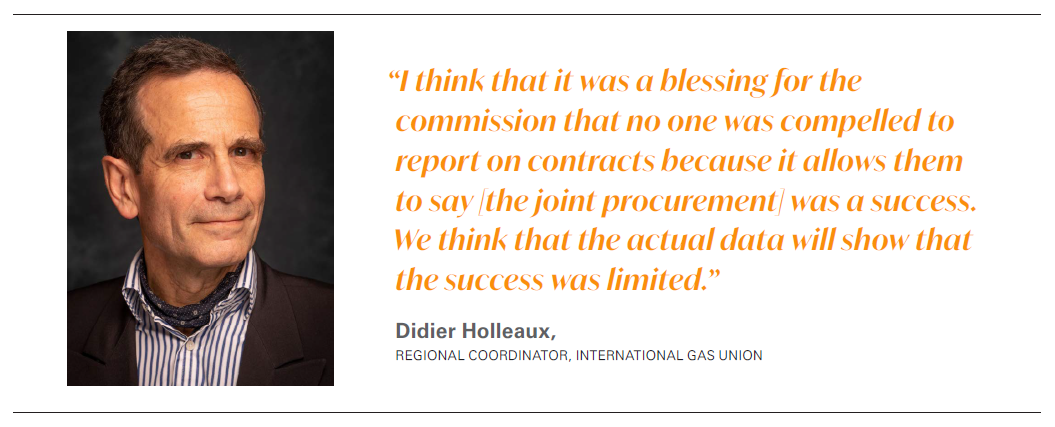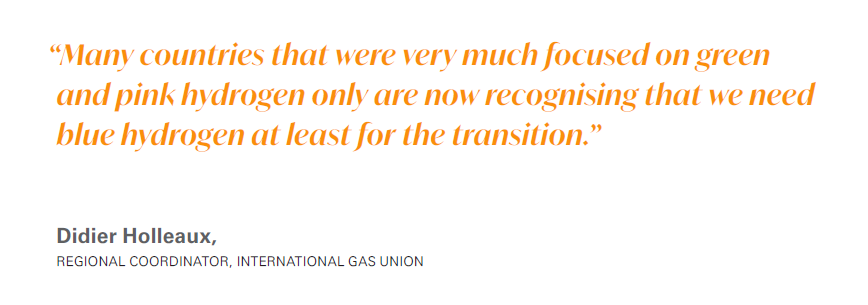Europe “ready as it can be” for upcoming winter: interview [Gas in Transition]
Europe “is as ready as it can be” for the upcoming winter, with European natural gas facilities filled to close to full capacity well ahead of the start of the heating season and additional volumes being stockpiled in west Ukraine, Didier Holleaux, regional coordinator at the International Gas Union, tells NGW. But he warns that risks remain, noting that in the event of a cold winter and/or further disruptions to Russian pipeline and LNG supply, steps might still have to be taken to restrict consumption.
The EU’s gas storage facilities were 94.4% full as of September 16, equating to around 97.2bn m3 of gas stored, while traders had accumulated a further 1.8bn m3 in Ukraine as of September 13, according to the country’s energy ministry. Ukrainian authorities say that foreign customers could use more than 10bn m3 of storage, mostly in the country’s west, far from the front lines from the war.
Meanwhile, the front-month TTF gas price has generally been stable at around €30-35/MWh ($340-400/’000 m3) in recent months – still high versus historic norms but much lower than the same time last year.
“In a nutshell, we could not be in a better situation, but if something major happens – very cold weather, major incidents affecting LNG flow or additional disruption of the flow from Russia to Europe – we may still have to curtail demand,” Holleaux said.
Russian gas pipeline flow to the EU came to 2.6bn m3/yr in August, up 8% month/month due to the country’s becoming more competitive versus regasified LNG. This is over 30bn m3 on an annualised basis – a far cry from the 137bn m3 delivered in 2021. H0lleaux does not rule out that Russia could restrict supply further this winter, but sees it as unlikely, as Moscow has no interest in cutting off countries that still receive its gas in Europe that it still has comparatively good relations with, such as Hungary.
Russian supply could still be disrupted in the event of sabotage of pipelines, as happened at the Nord Stream pipelines last autumn. The Kremlin has repeatedly accused Ukraine of attempted attacks on the TurkStream pipeline in the Black Sea. Holleaux views a partial cut-off in Russian supply as “manageable, although the safety margin is small,” which would make Europe vulnerable if the weather was also unusually cold this winter and there were also disruptions in LNG supply. The impact of such disruptions was demonstrated when the looming threat of strikes at Australian liquefaction plants caused TTF prices to spike in the second half of August.
Joint gas procurement a failure?
The European Commission has hailed the EU’s two joint gas purchasing tenders held this spring and summer as a success. The tenders aggregate buyers’ gas needs and suppliers then submit bids, and then buyers and suppliers are matched together and can negotiate contracts. Through this joint procurement process, the aim is to drive down the price.
In the first round, 25 suppliers offered 13.4bn m3 of gas, surpassing the aggregate demand of 11.6bn m3, with European Commission vice president Maros Sefcovic describing this as result as a “remarkable success.” The second round saw suppliers file bids for 15.2bn m3, falling short of the aggregate 15.9bn m3 sought by buyers.
 But these results alone are not a measure of the success of the procurement process, Holleaux stresses, as it does not reveal how much of the matchmaking between buyers and suppliers actually led to firm contracts, and companies are under no obligation to reveal those contracts or their details. All the information Holleaux has indicates that very few contracts were actually signed.
But these results alone are not a measure of the success of the procurement process, Holleaux stresses, as it does not reveal how much of the matchmaking between buyers and suppliers actually led to firm contracts, and companies are under no obligation to reveal those contracts or their details. All the information Holleaux has indicates that very few contracts were actually signed.
“I think that it was a blessing for the commission that no one was compelled to report on contracts because it allows them to say it was a success based on matching alone,” he says. “We think that the actual impact (volume and price), when we know it, will show that the success was limited.”
Nevertheless, the commission has said it is interested in using the mechanism for joint purchases of other commodities and, according to a Reuters report in early September, it wants to make it a permanent means of acquiring gas, although participation would be voluntary unless in the case of a supply crisis.
The procurement process was useful in terms of putting more buyers and suppliers in communication with each other even if the result was not fruitful, Holleaux says, although he does not see the need to make it a permanent fixture, as it can be re-introduced when needed very quickly.
Holleaux wants the commission to take a more realistic and less contradictory approach to gas demand forecasting, but he believes that this has not deterred buyers from entering into long-term contracts. Those buyers that want the price stability that long-term contracts offer have signed them, while others have preferred to take on the price risk rather than the long-term volume and will rely on shorter-term deals. In the case of the latter, this has enhanced the role of suppliers with large volume portfolios, such as the majors.
No rationale for banning Russian LNG
Various European policymakers have talked up the prospect of restricting Russian LNG imports, which unlike the country’s pipeline supplies have soared over the last two years as a result of high prices. They were up 43% last year at 19.3bn m3, and the commission has said it expects them to remain at the same level or grow further in 2023.
Holleaux sees no rationale for banning Russian LNG, however. Russia has demonstrated it would be able to divert this LNG to other ports in Asia even in winter, with the help of ice-class LNG carriers and ship-to-ship transfer. Russian export volumes would therefore be unchanged. More of the country’s LNG would simply flow to Asia, and other suppliers would respond by diverting more shipments to Europe. The only impact of a ban would therefore be higher transport costs and increased CO2 emissions, Holleaux says.
“At the end of the day, the global LNG balance would be unchanged,” he says.
In any case, hurting the revenues of Russia’s main LNG exporter Novatek would have limited impact on the Russian government’s budgetary funds. Novatek’s shares are all held by private investors save for a 9.4% stake held by state-owned Gazprom. And its Yamal LNG project is exempt from export duty and mineral extraction tax.
Green gas momentum builds
Holleaux sees strong momentum building behind biogas development in Europe. Interest is growing in countries where its production has so far been marginal, he explains, and a number of projects are coming into fruition in key producers such as Denmark and the Netherlands. Governments are also placing more emphasis on biogas.
Reaching the EU’s 35bn m3/yr target for certified biomethane production by 2030 cannot be guaranteed, but Holleaux is optimistic that this is achievable. The gas industry is working to get this objective embedded in an EU directive, and ensuring there are no legislative constraints on biogas and green hydrogen development.
Holleaux sees increased “openness” in Europe to blue hydrogen as a transitory fuel that can spur the development of a ready market for green hydrogen in the future.
“Many countries that were very much focused on green and pink hydrogen only are now recognising that we need blue hydrogen at least for the early transition,” he says. “How long the transition lasts is an open question which will depend on how quickly green hydrogen develops.”



